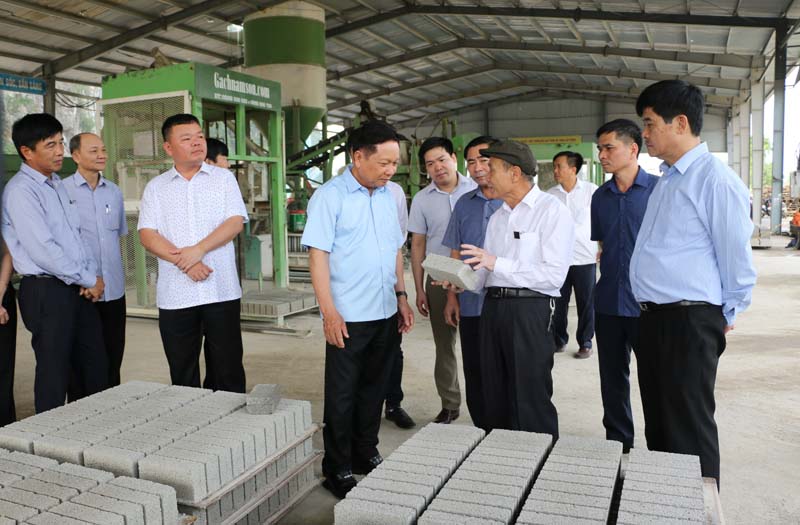
(HBO) – Mr. Hoang Duy Phuong was born in 1950 in a studious poor family. Up to now, in spite of being at the old age, Mr. Hoang Duy Phuong, Director of Nam Son Co., Ltd, is still nimble.

Mr. Hoang Duy Phuong (wearing a hat and
standing at the middle)
In 2014, his family boldly borrowed budgets
from the bank to establish Nam Son Co., Ltd, and bought stone mines in Yen Binh
hamlet, Doan Ket commune in order to exploit limestone for building materials
as well as serve the production needs of the people in the area and surrounding
areas with the total investment of 8.5 billion VND. Especially, the owned
capital was 5 billion VND and the borrowed capital was 3.5 billion VND.
In 2016, in order to implement the Decision
No. 1469/QD-TTg dated 22/08/2014 by the Prime Minister about approving the
master plan of developing construction materials in Vietnam by 2020 and
orienting by 2030, Mr. Hoang Duy Phuong has boldly invested in the production
chain of non-baked bricks, and the investment capital of stone quarry and the
production chain of non-baked bricks was 21 billion VND.
Currently, all activities at the factory of
non-baked brick production of Nam Son Co., Ltd were fully automated. In 2016,
the output of brick reached 3 million tablets including some of solid bricks,
two-hole bricks and three-wall bricks. In 2017, the output increased to 6
million tables. At the same time, the company continued to invest more in the
production chain of Tazero bricks with the investment capital of nearly 900
million VND. Particularly, the budget for support of Hoa Binh province was
nearly 194 million VND.
In 2018, Mr. Phuong continued investing to
expand the factory and auxiliary works with the total investment of 9 billion
VND. Especially, the capital in application support and transfer of science of
technology programs in order to service economic and social development in the
rural, mountainous and ethnic minorities areas during period of 2016 to 2025 by
Ministry of Science and Technology was 4.03 billion VND. It is expected by the
end of this year that the chain will be put in operation, and create jobs for
about 20 local workers with the average income from 4 to 5 million VND per
person per month. The expected output in 2018 of the enterprise will reach
about 9.5 billion VND.
According to data from the Hoa Binh Provincial Party Committee, the industrial production index for the first six months of 2025 is estimated to have increased by 20% compared to the same period last year. This marks the highest year-on-year growth rate for this period since 2020.
In the first six months of 2025, Hoa Binh province’s export turnover was estimated at 1.145 billion USD, marking an 18.11% increase compared to the same period in 2024. Import turnover was estimated at $ 804 million, a 17.15% increase, which helped the province maintain a positive trade balance.
The lives of the ethnic minority farmers in Tan Lac district have gradually improved thanks to the new directions in agricultural production. This is a testament to the collective strength fostered through the professional associations and groups implemented by various levels of the district’s Farmers’ Union.
With the motto the "product quality comes first,” after nearly one year of establishment and operation, Muong village’s Clean Food Agricultural and Commercial Cooperative, located in Cau Hamlet, Hung Son Commune (Kim Boi district), has launched reputable, high-quality agricultural products to the market that are well-received by consumers. The products such as Muong village’s pork sausage, salt-cured chicken, and salt-cured pork hocks have gradually carved out a place in the market and they are on the path to obtaining the OCOP certification.
In the past, the phrase "bumper harvest, rock-bottom prices" was a familiar refrain for Vietnamese farmers engaged in fragmented, small-scale agriculture. But today, a new spirit is emerging across rural areas of Hoa Binh province - one of collaboration, organisation, and collective economic models that provide a stable foundation for production.
Maintaining growing area codes and packing facility codes in accordance with regulations is a mandatory requirement for agricultural products to be eligible for export. Recently, the Department of Agriculture and Environment of Hoa Binh province has intensified technical supervision of designated farming areas and packing facilities to safeguard the "green passport" that enables its products to access international markets.



